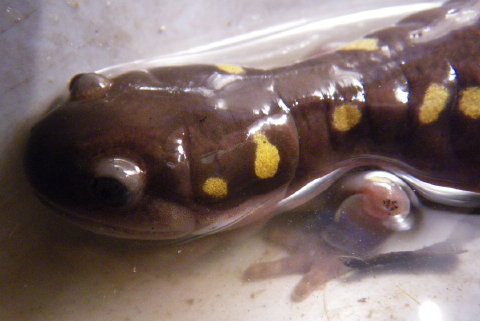Spotted Salamander (Ambystoma maculatum)
It’s ten o’clock at night, pitch black, with torrential downpours from a persistent coastal storm that has flooded shorelines from New Jersey to Massachusetts. Why would any sane person venture into the swampy wetlands of SouthCoast Massachusetts to investigate what happens in the dark shadows of a rainy spring night? Luckily, Turtle Journal needs not concern itself with sanity. So, we pulled on our boots, slipped into our slickers, clicked on our headlamps and sloshed through the flooded wetlands … in search of loved crazed amphibians.
Why Did the Spotted Salamander Cross the Road?
Slipping and sliding through swampy backroads and bouncing through bottomless puddles, we reached an abandoned cranberry bog in Marion on the SouthCoast of Massachusetts. Approaching the bog, we spied a spotted salamander that had gone “tharn” (a coined word from Watership Down to describe a creature frozen in place) in the middle of the road from the blaze of our headlights. Why do they cross the road on these dark, rainy spring nights? The simple answer is that they are impelled by biology to journey from their over-wintering sites to mating aggregations, called congresses, when the warm spring downpours arrive in late March or early April.
Slithering Salamanders!
Spotted salamanders are delightful critters. Females larger than males; males faster than females. Bright yellow spots running down their bodies in two parallel lines. In the water they swim with grace, while landward they slither and waddle.
Releasing Spotted Salamanders
We couldn’t forget to mention the outrageous and cacophonous chorus of critters that bellowed for attention while accompanied by the steady, staccato cadence of torrential downpours. We estimated this musical rendition at about 120 dB (decibels) loudness; that is, 5 db above a sandblaster and 5 dB below a pneumatic riveter. Watching our new friends disappear into their mating pond already adorned with large egg sacs from several days (and nights) of stormy love proved a beautiful sight as they gracefully swam in seeming choreographic synchrony with Nature’s version of a Little Amphibian Night Music.
